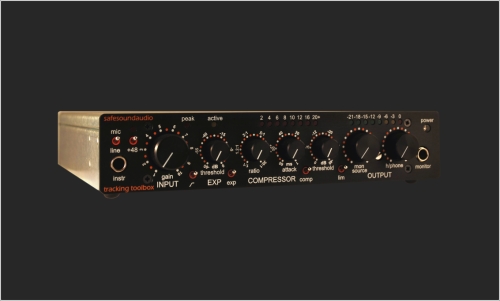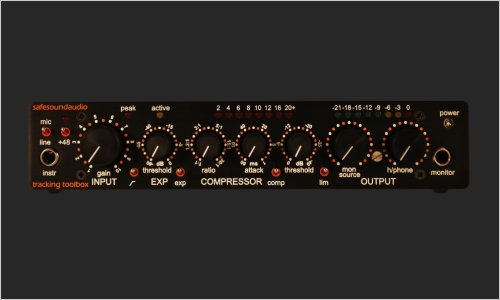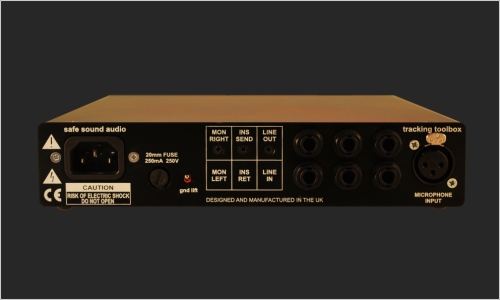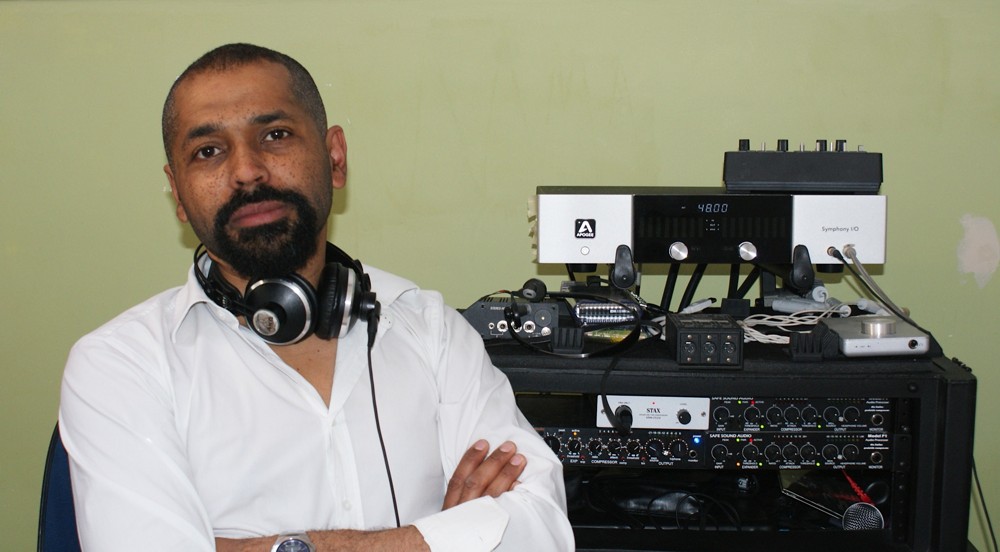
Tracking Toolbox



This is our premier tracking toolbox for vocals and other sources requiring a wide open mic pre combined with the best tracking compressor on the market.
Classic Class-A discrete transistor mic amp feeds a second servo IC stage to boost the maximum gain up through 70dB, well beyond most of the single stage Class A designs.
Peakride compression is very easy to dial in when tracking and evens out levels in a very musical way without robbing the sound of life, so bringing the performance a new energy.
Use the toolbox to track with confidence and it will give you great results and inspire confidence when you have difficult dynamic sources to work with.
Use it live when you need a portable rugged high quality mic pre/compressor for the lead vocal. A life saver when you’re touring and have to mix on the house PA.



Ronny Mosuse reviews the Safe Sound Tracking Toolbox
About me:
Ronny Mosuse, 40 something, singer/songwriter/composer/producer.
I perform and record my own music and I do a lot of production work for other artists and companies as well. When I'm recording myself I'm more of a recording hobbyist than a sound engineer as I never take enough time to prepare for recordings. I can do as many takes as I like anyway... but when I'm recording somebody else, I always stay focused on the talent and what he/she does in the first place. I've been performing enough (before microphones - in studios - before engineers and producers) to know that doing so can be a stressful job and to realise that the energy and the performance of the talent have a short lifespan.
Nowadays, because of renovation works at our house, I'm kind of 'studioless'. So I've been moving the minimal amount of equipment to be able to work from room to room …

My first Safe Sound Audio P1:
I use a Mac Pro with the Apogee Symphony and Ensemble when recording at home and a MacBook Pro with the Apogee Duet 1 on location. The Symphony and Ensemble have built in soft limiters on all inputs. So, when switched on, the AD converters will never clip. With the Duet on location however , I don't have that luxury. And on location, for some reason or another, there always seems to be less time and more stress … So, to be safe, I started looking for a pre-amp / recording channel with built in limiter. It needed to be something simple, with a mic preamp of great quality. Searching the internet a few years ago, I stumbled upon the P1 from Safe Sound Audio. I must admit that it was the price and the "not satisfied? Money back!" guarantee that persuaded me in the first place to order one. But after the first recording (bass) I made, I was delighted. It did everything that I wanted it to do (which was simply to control the level but in a very transparent way and to make sure all my recordings were useable (at a technical level)). From that day on, everything (even at home) passed through my SafeSoundAudio P1 and I used my Apogees only for the converting part. The great quality pre-amp and the compressor made it an ideal tool for any recording task.
Old school peak riding:
Most professional-gear-companies talk about their products as if they were the best and I've decided long ago to only trust my ears when choosing the right stuff. But in the case of the P1, not a single word on the website of Safe Sound Audio was exaggerated. It was just that simple to use, good sounding, mic pre with a very easy to setup compressor and a life saving limiter. Around that time I had also been reading about old school sound engineering techniques especially about how they, back in time, used to follow the talent with a fader after the preamp and before sending to tape. To keep the peaks and the volume of the performance under control that was. When reading the manual of the P1, I recognised the same technique, apparently, called "peak riding". Don't know exactly how the P1 does that, but I know it works. It feels as if an old school engineering sits beside me while I'm recording myself or someone else and that's a comforting feeling.
The Tracking Toolbox:
So lately, when I heard about the updated version, the Tracking Toolbox, I immediately ordered one (that is to say, after I ordered another P1 first...) because I read about the extra gain of the TT's mic pre and the ability to input instrument jacks on the front panel.

And also, recently I started to use ribbon microphones (a lot) and I wanted to check how they sounded through the Tracking Toolbox with that extra mic gain. Once again it was all that I hoped and longed for. Transparency, peaks under control, no hearable compression (unless you push it to the limits), and all of that quite easy to achieve… I also have this mic pre/eq from Amek/Neve (System 9098) besides my Apogee pre 's but I still prefer the Tracking Toolbox. When I listen back or do some A/B-ing (I use KOSS ESP950 Electrostatic Headphones and STAX SR-003 in-ear-speakers) I do not notice a difference in mic pre quality between the Apogee and the Tracking Toolbox (or P1). I do hear that the Apogee 's top high and sub low (under 35 Hz) are a little bit hyped and sound a bit more coloured. I guess as a result you hear that slightly more pronounced sound. So nowadays, in function of the source that I'm gonna record or the sound that I'm after, I chose or the Tracking Toolbox mic pre or the Apogee mic pre. But nevertheless, I will always use the TT as an inserted expander/compressor/limiter. It's a question of simple mathematics: so far, I have never ever made a bad recording with the Tracking Toolbox in the recording chain! Without the TT on the other hand …
I A/B 'd with the Amek/Neve 9098 as well: 'though it has a very well equipped EQ that can work with surgical precision when in good hands, its mic pre can't compete with the Tracking Toolbox because of the noise when turning up the gain...
Tracking Toolbox forever:
The Tracking Toolbox for me is what it says it is: a fantastic toolbox. For example, with the hi pass filter on when tracking vocals (assuming you have chosen the right microphone for the singer of course...) there 's no need for EQ-ing while recording. All of the transients of the various frequencies stay perfectly under control. You really have to try very hard to screw up a recording technically with the Tracking Toolbox. The expander function is also a very welcome tool for times and places where you don 't have the background noise under control... (like at my place when the kids are at home)
Another great thing is the monitoring feature. To be able to isolate the signal before it hits the AD converters and the hard disks ... No latency, tweaking the sound while recording without disturbing the talent ... simple but clever.
So far I've been recording acoustic guitars, double bass, electric bass, mandolins, ukuleles, voices, recorders, percussion, autoharp, etc... with the Tracking Toolbox and everything sounded natural and under control.
I've seen a lot of well trained sound engineers searching and tweaking with mic pre's, compressors and equalisers before recording a single note and I've learned that the amount of time spent while doing so isn't necessarily in conjunction with the result… Well, the Tracking Toolbox and P1 never disappoint you and hardly take time to set up!
I will always keep using this great little thing because it saves me a lot of time when recording and mixing.
(gear I often use to record stuff: Pro Tools 10, Logic Pro 9, AKG 414 B-ULS, Royer 121, Neumann U87, Neumann U47, Oktava MK12, ShinyBox 46 MXL, Microtech Gefell M930, Rode K2, Genelecs, EQUATOR Q8, KOSS ESP950, STAX SR-003, NS10 's)
Ronny Mosuse

Safe Sound designer Robert Campbell discusses the design philosophy behind the new Tracking Toolbox.
I thought to write a short blog about our decision to finally retire our P1 Audio Processor from production (on its eighth anniversary!) and introduce a new tracking toolbox with significant audio feature and performance improvements”
“If you’ve ever popped the lid off our original P1 half rack channel strip then you’ll know it was already a very busy place inside. So deciding to update the design extensively with intent to add a whole bunch of new features was a decision taken with some trepidation … but we do like a challenge. First up was to revisit the mic amp design.
Many of the traditional Class A mic amp designs use input transformers coupled to single discrete op amps. This combination yields typical maximum gains of between 60 and 65dB, maximum input headroom of between +9 to +12dBu (so they usually offer a switchable 20dB pad to cope with hot inputs) and a useable frequency response of around 30kHz at maximum mic amp gains.
With many studios now installing A/D converters offering sample rates up to 192kHz, many recording set-ups now have achievable audio bandwidths up in the range of 50kHz to 70kHz. Taking account of the never ending debate about the importance of ‘out of audio band’ frequency response, we decided to design a mic amp capable of at least 50kHz ‘analogue’ bandwidth even at maximum mic gain. As our reputation is for low colouration products, we also decided to work with a transformerless front end. You can always add colour later, but it’s not so easy to take it away!
The design approach we settled on combines a Class A discrete transistor front end, coupled to two further stages of IC based amplification, with two current feedback circuits providing the hi-gain/wide bandwidth performance we wanted to achieve. There are a number of advantages to this approach;
- The discrete front end stage is not attempting to provide all the mic gain on its own. This extends the available audio bandwidth at high mic gains and greatly reduces mic amp distortion especially at high mic gains.
- Mic gains up and beyond 70dB are easily achievable. We could have gone further but working with 70dB of gain on a single gain control knob is quite enough, and we have another 21dB of gain available on the Toolbox’s line output stage should you need to offer high levels into your system’s A/D converters.
- With the first mic amp stage working in Class A, we should be able to achieve a very low distortion performance with no measurable crossover distortion at the mic amp output.
So how did it work out in practice?
We’re measuring frequency responses of -0.5dB at 63kHz with the mic amp working at its maximum gain of 70dB, extending to -0.5dB at 150kHz at unity gain.
Distortion when measured at the output of the mic amp is less than 0.003% with no measurable crossover component and we’re seeing noise figures measured at an EIN of 128dB.
With no input transformer to saturate, maximum input level is in excess of +20dBu so there is no need to use a pad when connecting to very high output level microphones.
This multistage mic amp design also provides very convenient access points for balanced line level and hi-Z unbalanced inputs, with the ability to set the gain for these inputs within the range desired. For the tracking toolbox we have set the three gain ranges at;
- Balanced Microphone input : -5dB to +70dB
- Balanced Line input : -10dB to +20dB
- Unbalanced hi-Z Instrument input : +4dB to 35dB
which we think matches typical user requirements very well.
The pre-amp can be accessed as an impedance balanced output, via the insert send jack, for routing directly to your recording device. So completely independent from the dynamics section, when compression during tracking is not required. (A switchable high pass filter operating at 80Hz, and a slope of 18dB/octave, is provided.) This arrangement also allows the dynamics section to be used completely independently if required.
Source Switching
We received plenty of feedback from folks who loved the P1 but didn’t want to spend so much time visiting the rear of the unit to switch sources (means plugging and unplugging). So we took the hint and (somehow) found space on the front panel for the Hi-Z instrument input and a very neat little mic/line selection switch. Source switching is now done internally using sealed gold-alloy contact relays and we’ve moved over to 100% Neutrik audio connectors.
The compressor
I designed peakride compression nearly ten years ago and it’s received a lot of critical acclaim for it’s ability to track dynamic sources very well, especially vocals. The design objective was, from the beginning, to provide effective control of dynamics with minimal pumping whilst retaining the vitality of the performance. It also had to be easy to set up!
The final design arrived at uses a VCA compressor controlled by three linked side-chains. A lot of experimentation was done with a variety of sources, especially vocals, but also with acoustic piano and bass. Focusing in on vocal compression, we configured the three side chains as follows;
Side-chain 1 : a fast attack, fast release compressor which catches these over excited vocal phrases but recovers very quickly.
Side-chain 2 : a medium attack, medium release compressor which smoothes out the release response of side chain one.
Side-chain 3 : a slow attack, slow release compressor (but not too slow!) to provide very low distortion on sustained vocal phrases which often cause problems due to ‘ripple’ of the vocal modulating the control chain.
It’s a critical aspect of the design that the three side-chains have different ratios and knee characteristics which are mixed together in varying levels of contribution to work in harmony providing a ‘peakride’ compressor response.
The result is a variable (slightly) soft knee adaptive compressor which provides the following key advantages;
- Fast short attack transients are well controlled without over compression.
- A programme related auto variable release time was possible making set up of the compressor much faster and simpler.
- ‘Ripple’ audio distortion has been almost totally eliminated without very long release times being necessary (slowest release time is only 500ms).
The limiter
The original P1 limiter was an attempt to design the perfect audio limiter (must have been a long winter that year!) The design did achieve true ‘look-ahead’ detection of clipping which controlled a dynamically variable threshold, so that, what was in essence quite a slow limiter, could prevent any audio excursion above the preset audio limiter threshold. It was incredibly complex but on the whole it worked extremely well. It’s main weaknesses were a tendency to slightly over limit on certain types of material, and it was not really suitable for using as effect when driven hard intentionally.
The limiter design used in the Tracking Toolbox retains a very small amount of predictive capability but this is coupled with dynamic control of attack time. This limiter design has the capability for short burst attack times as fast as 100us, but only when required to catch very fast transients. Most of the time it works with a ‘natural’ attack time of around 1ms which produces much lower distortion especially with complex low frequency sources such as synth bass.
You’ll find variants of this design in both compression and limiter applications within our other products.
The expander
The P1 expander was designed as an easy to use one-knob expander for a wide variety of uses and could turn its hand to drum gating when required. However the feedback we got from users of the P1 was that the expander was being used primarily by voice over artists, presumably working in less than ideal acoustic spaces with PC fans and the like causing all sorts of recording challenges. They complained (very politely) that the P1 expander operated too abruptly for the spoken work and that the ratio was too high.
The new expander design in the Tracking Toolbox goes a long way to solving these issues. I have lowered the ratio from 1:3 to 1:2 and have redesigned the auto hold and auto release circuitry so there is little tendency for the expander to kick in mid phrase.
Maybe it’s not so flexible as a general purpose gate but we wanted to react to the user feedback and that’s what we’ve done.
Monitoring and Main Output
We have lots of P1 users who record straight ‘into the box’ and don’t have separate monitor mixers, so the new Tracking Toolbox retains the stereo mix section and integral headphone amp with the ability to level blend your tracking source into the monitor mix.
We’ve also taken the opportunity to beef up the line output stage so it can now deliver a massive +27dBu into 600ohms, and we’ve added a ground lift switch which can help to take care of ground loop problems which occasionally arise.
And it’s still 100% analogue!
In bringing so many audio features into the half rack format, it is sometimes tempting to take the same path as many other audio designers and use an external ‘wall wart’ or ‘in-line’ mains adapter. They have many advantages; a large amount of space is saved within the case, they can be very power efficient, they have less tendency to suffer from ground loop problems, and …the list goes on
But the same temptation can lead you to source a low cost ‘off the shelf’ switched mode PSU which provides the required dc supply voltages but with the addition of large amounts of high frequency crap, typically in the region of 150kHz. This is very difficult to fully filter out within the audio unit, and all I can say is that the majority of these ‘stand-a-alone’ adapters which I’ve had ‘on the bench’ should be no where near a quality audio unit. Unfortunately many are!
So although it takes quite a bit of real estate, I’ve stuck to a traditional fully linear and integral mains PSU within the Tracking Toolbox. That means a very high quality toroidal mains transformer (manufactured by Nuvotem Talema for those who want to Google) and they are quite simply superb. Incredibly low radiated hum; small footprint for the power provided, and they’re blue! This feeds traditional linear regulators for the audio dual supply rails and, via an additional regulator, for the microphone phantom power.
As is often the case, this ‘short’ blog has rambled on a bit, but I hope it has offered a useful insight into my personal design journey from P1 to Tracking Toolbox. As always, I’m happy to hear your views and comments."
Robert